
Reptiles & Amphibians
REPTILES
The reptiles are oviparous and its body is covered with scales, breath through lungs and are cold-blooded animals which get their energy from the sun heat. There are 3 families of reptiles: crocodiles, turtles, lizards and snakes.
• Crocodiles
There are 2 species, the American Crocodile (Crocodylus acutus) that can measure up to 7 meters, lives in both freshwater and salty one, in areas with great water flow, is carnivorous and lays its eggs in holes dug in the sand. The other kind is the Cayman (Cayman crocodilus) that does not exceed 3 meters. Length and prefer less rushing waters, is oviparous and lays its eggs in mounds that they make out of organic material.
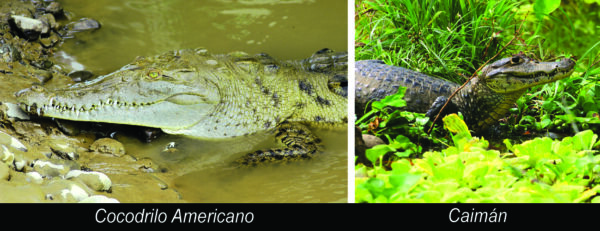
• Turtles
Among the 5 marine species are we find, the Green Sea Turtle (Chelonia mydas) which is the most abundant, grows up to 1.5 meters long and its spawning season goes between the months of July till October, in the entire Caribbean coast, especially in the Tortuguero`s National Park. The Leatherback Turtle (Dermochelys coriacea) is the largest one, with nearly 2.5 meters. in length and 750 kg. of weight, has a dark bluish gray colour with pink, or white spots and is covered in leather with seven longitudinal keels, spawns in the entire Caribbean coast, Tortuguero and Gandoca especially between the months of March and May. The others are the Hawksbill, the Olive Ridley and the Loggerhead ones. In freshwater we find the Black River Turtle (Rhinoclemmys funérea).
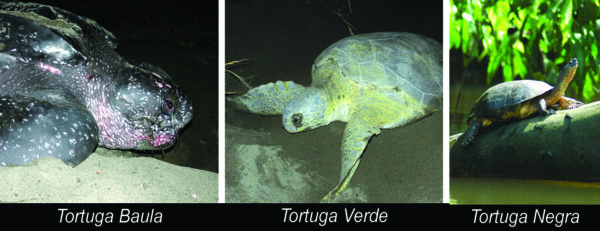
• Lizards
Among the lizard category we find lizards, iguanas, chameleon and basilisks, among others, with a total of 63 species in Costa Rica. The Green Iguana (Iguana iguana) is one of the most representatives of the Caribbean, can measure up to 60 cm. without the tail, inhabits the humid troppical forests up to a height of 500 meters, is oviparous and very territorial. The Emerald Basilisk (Basilisk plumiforme), known as Jesus Christ lizard, has the ability to run on water, has a small bright green and electric colour with blue spots and measures up to 25 cm. and is tailless. From the same family is the Jesus Christ Lizard (Basiliscus vittatus) of 14 cm, brown coloured to light olive with yellow lines on the sides
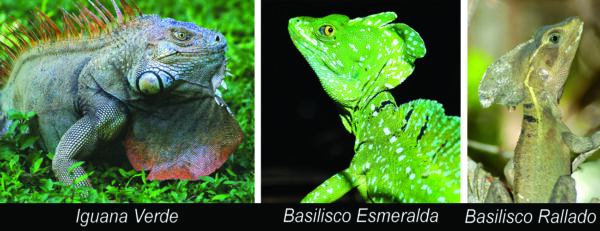
• Snakes
It is characterized for having an elongated cylindrical body, having a very flexible skeleton, dry skin, lack of good vision but thanks to a series of special organs they can feel the heat and smell so as to detect what is around them.
The non – venomous snakes are represented in 118 species. As for food, the larger species, such as Boas (Boa constrictor) base their food in small animals. Others feed exclusively on snakes as the Mussurana (Clelia Clelia) main predator of the poisonous Fer-De-Lance snake.
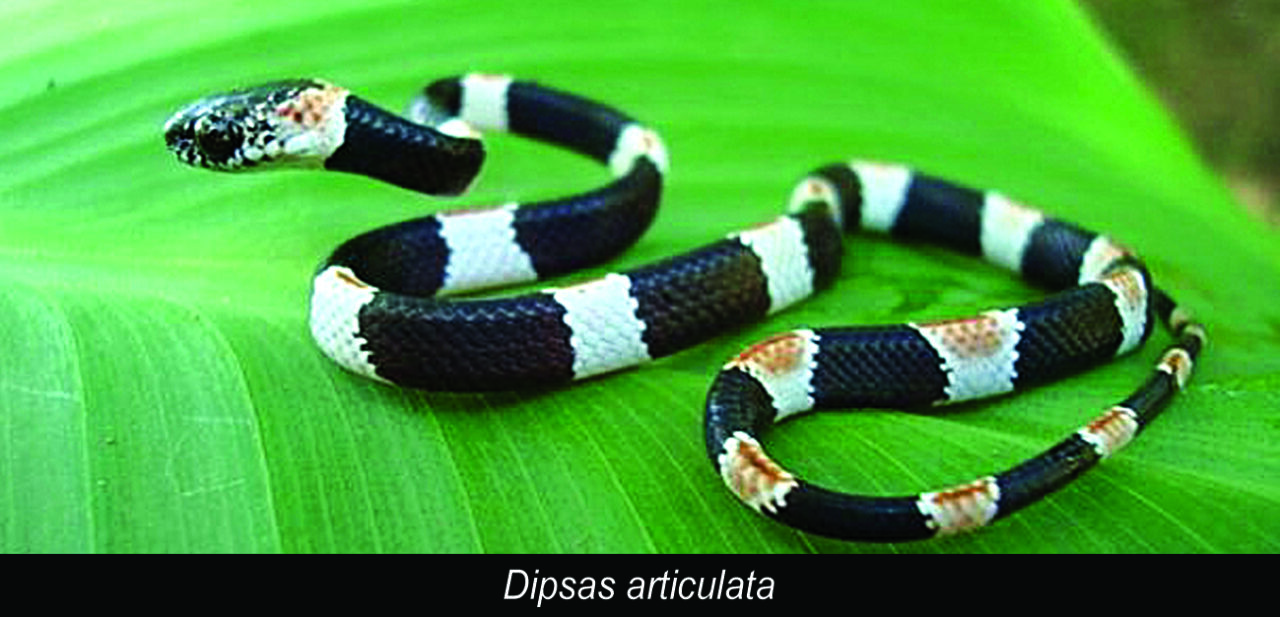
As for the poisonous ones we can find 18 species located in these families: Hydrophiidae (sea serpent), Elapidae (coral) and Viperidae (poisonous tobobos). There are 4 species in the family of Coral snakes, three of them with rings of black-red-yellow colours, around one meter long, whose venom is neurotoxic, and the Black Halloween snake (Dipsas articulata), with bi coloured rings, red and black or black and white.
Among the poisonous Tobobos there are 13 species such as the Bushmaster (Lachesis stenophrys), Fer-De-Lance (Bothrops asper), Eyelash Palm Pitviper (Bothriechis schlegelii) and Lora (Bothriechis lateralis) among others, whose venom causes tissue destruction and problems with blood coagulation.
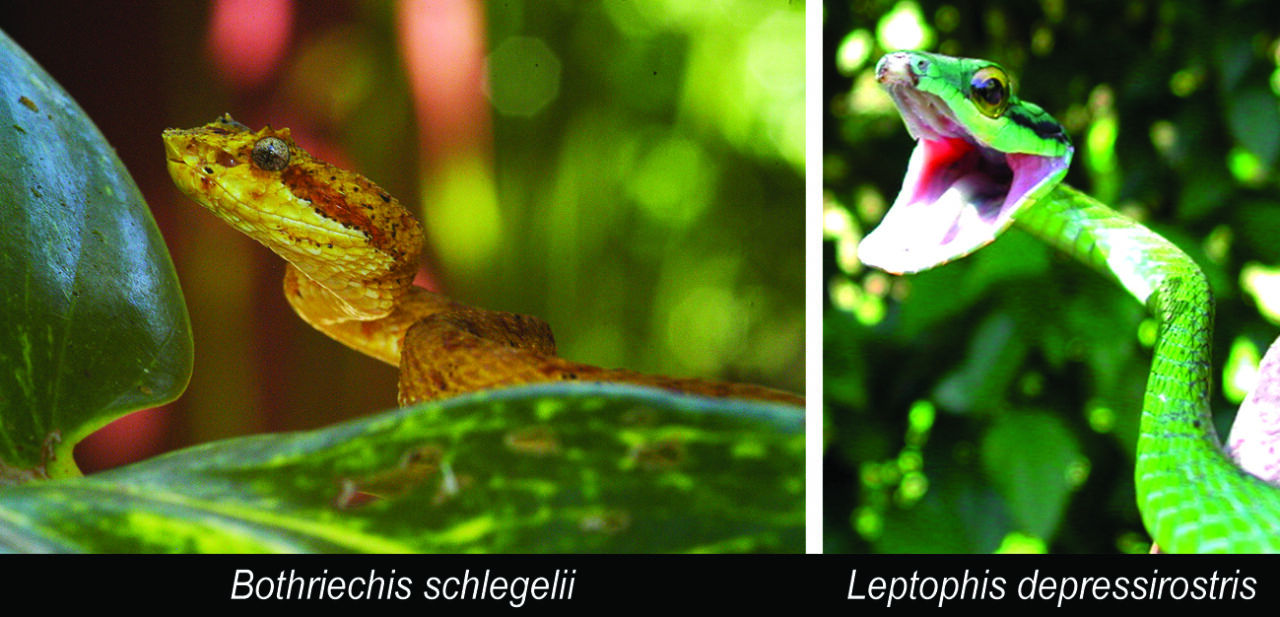
AMPHIBIANS
Amphibians are divided into 3 groups: ANURANS or tailless amphibians (frogs and toads), which we pint out the Dendrobates family, such as the Red Frog (Dendrobates plumilio) measuring about 2 cm. and is characterized by its red color on the back, stomach and part of the extremities, which can also be blue like the Blue Jeans Frog. The Green Frog (Dendrobates auratus) has bright colors ranging from green to blue with black spots, can measure more than 4 cm., and feeds on ants and small insects. The Dendrobates have glands in the skin that release poisonous substances, are more active during the night and live in the Caribbean´s rain forests.
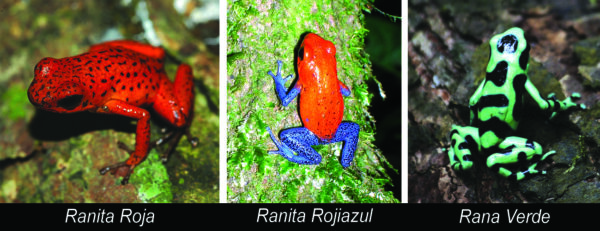
Another family of Anurans are the Agalichnys, which the Gaudy Leaf Frog or Red Eyed Frog Belongs (Agalichnys callidryas) they have large, bright eyes with red iris, vertical pupil and reticulated inner eyelid, its body has many colors, such as lime green, blue, purple, yellow, or orange and red. The male is 5 cm. long and the female i7.6 cm., of nocturnal habits, arboreal, and carnivorous. Fleischmann’s Glass Frog (Hyalinobatrachium) are nocturnal and arboreal, have very thin and translucent skin allowing you to see its internal organs. Among the toads you find the Giant Toad (Bufo marinus), which grows up to 20 cm.

Another type of AMPHIBIANS are the onesthat have tail, such as the Salamanders, represented Plethodontidae family, and although they are similar to lizards, they are distinguished by their skin always moist and without scales. Then you find the CECILIAS, amphibians similar to worms, of underground habits, without limbs and blind.

Fotografias de Paco Salmerón
Texto de Juan Carlos Lorite y Paco Salmerón
Diseño de Juan Carlos Lorite